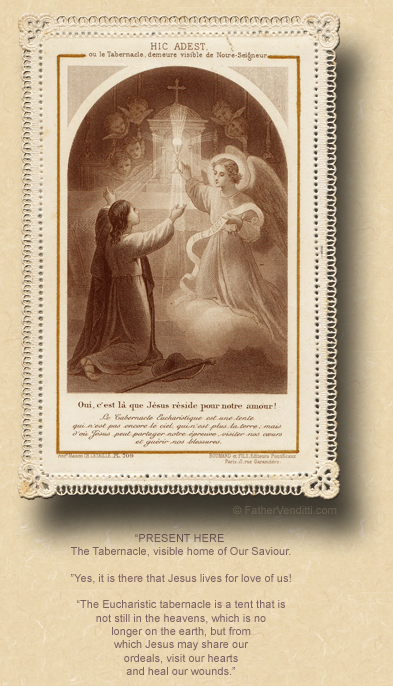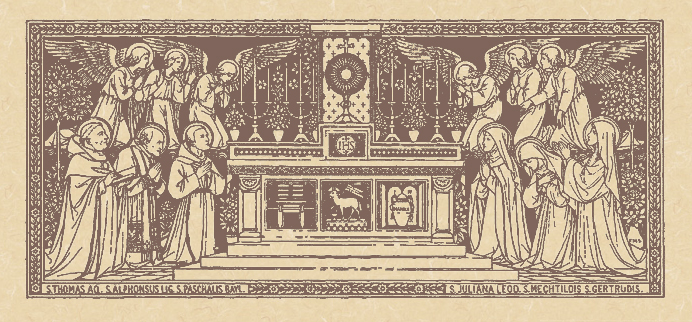Am I a Bad Catholic if I Don't Watch the Pope on TV?
The Twenty-Fifth Thursday of Ordinary Time.
Lessons from the primary feria, according to the ordinary form of the Roman Rite:
• Haggai 1: 1-8.
• Psalm 149: 1-6, 9.
• Luke 9: 7-9.
The Seventeenth Thursday after Pentecost; and, the Commemoration of Our Lady of Ransom.*
Lessons from the dominica,** according to the extraordinary form of the Roman Rite:
• Ephesians 4: 1-6.
• Psalm 32: 21, 6.
• Matthew 22: 34-46.
The Seventeenth Thursday after Pentecost; and, the Feast of the Holy Martyr, First Among Women & Equal to the Apostles, Thecla.
First & third lessons from the pentecostarion, second and fourth from the menaion, according to the Ruthenian recension of the Byzantine Rite:
• Ephesians 5: 33—6: 9.
• II Timothy 3: 10-15.
• Luke 4: 16-22.
• Matthew 25: 1-13.
FatherVenditti.com
|
 1:54 PM 9/24/2015 — In case it had escaped your notice, the focus of the Missal these days has been on the Old Testament, and some very obscure parts of it that it would never occur to us to read if we simply sat down with our Bibles. We had been romping through the Book of Ezra, today and tomorrow we're given the Book of Haggai, and after that Zechariah. These lessons from the minor prophets have been long, and the Gospel lessons so short, that it's very easy to simply zone them out. That's why, when I've chosen to preach at daily Mass recently, I've been focusing on whomever is the saint of the day. 1:54 PM 9/24/2015 — In case it had escaped your notice, the focus of the Missal these days has been on the Old Testament, and some very obscure parts of it that it would never occur to us to read if we simply sat down with our Bibles. We had been romping through the Book of Ezra, today and tomorrow we're given the Book of Haggai, and after that Zechariah. These lessons from the minor prophets have been long, and the Gospel lessons so short, that it's very easy to simply zone them out. That's why, when I've chosen to preach at daily Mass recently, I've been focusing on whomever is the saint of the day.
As you can see, there is no saint today. I'm deliberately not watching the Holy Father on television, so I can't comment on what he may be saying, which is probably a good thing for both you and me. The Holy Father did canonize Father Serra, which is a good thing since he was a very great priest, but I preached about him already this year back on his actual feast day. And the prudent thing today would probably be not to preach at all, but I never was all that prudent.
The Book of Haggai is obsessed with one question: to rebuild the Temple or not, and to understand it some history is in order. In 597 BC, Nebuchadnezzar, King of Babylon, took Jerusalem in response to a rebellion on the part of the Jews. The treasures of the Temple of Solomon were plundered, and the Jewish people—some of them—were dispersed through his empire. The Jews revolted again in 587, just ten years later, and this time Nebuchadnezzar was more severe: he laid siege to Jerusalem for eighteen months, destroyed the Temple, and deported almost all the Jews with only a handful of the poorer classes left in what was left of the city. Many if not most of the Psalms were written during this period, and sing of the longing of the people to return home. The Babylonian empire was invaded and conquered by the Persians in 539, and the following year King Cyrus issued a decree allowing the Jews to return home and rebuild their Temple, which is what the Book of Ezra, which we were reading the first half of this week, is all about; but, after laying the foundations of a new temple and erecting the altar of holocausts, the project ground to a halt for lack of resources, and lay unfinished for a long time. In 520, the prophets Haggai and Zechariah appear, encouraging the Jews to find a way to resume the project.
Very little is known about either of these men. Haggai's oracles are all dated, and fall within a span of just four months. There are five: an exhortation to the people to rebuild the Temple, a prediction of its future glory, why the offerings of the unclean need to be rejected, the promise of immediate blessings if the project is completed, and a pledge to the Jewish King Zerubbabel should the Temple be finished in his reign; and, the Temple was, in fact, finished in 515.
Like most prophets, Haggai regards himself as nothing more than a mouthpiece for God, speaking to the people in God's words, telling the people that they need to rebuild the Temple both so that He, God, will have a place to dwell, and so that the people will have a place where they can go and see Him face to face. Of course, even with a Temple, the so-called face to face presence of God wasn't real, and wouldn't become real until God, Himself, became a Man and walked this earth in the Person of Jesus. Our Lord, Himself, alludes to this near the beginning of His public life, when He tells the Jews, “Destroy this temple, and in three days I will raise it up” (John 2: 19 RSV), referring, of course, to Himself as the new Temple. So, the Temple was really a prefiguring of the incarnation.
And that's really the key to understanding what's happening in these books of the minor prophets. The Temple of Jerusalem was an outpouring of the faithful's desire to see God; it was realized for them in Christ, except that they missed it—most of them—because they were expecting a Temple of stone, not one of flesh and blood … which gives a context to the very brief lesson from Luke's Gospel in which a more modern king of Jerusalem, Herod, is confused: having put John the Baptist to death for preaching against his invalid marriage, now Someone else has come along with the same message, even being told by some of his handlers that “One of the ancient prophets has arisen” (9: 8 RM3). The brief lesson ends with the words: “And he kept trying to see him” (v. 9 RM3). So are we … trying to see our Lord, that is. Only we don't have to build a temple to do it; all we have to do is visit our Lord in the tabernacle.
A lot of people this week are thronging to Washington, Philadelphia, New York, to catch a glimpse of the Pope. I'm obviously not one of them, not because I have anything against the Holy Father; but, why put myself out to be in the presence of Christ's Vicar when it's so much easier to be in the presence of Christ? Our Blessed Lord wasn't just speaking figuratively when he described Himself as a Temple that would be rebuilt in three days. He is, as the Fathers of the Church always said, the living Icon of God, because He is God, and is right here among us.
Let's resolve to put ourselves in our Lord's presence frequently. If we can't do it by visiting the Blessed Sacrament physically, then let's do it by making a spiritual communion. Then, we can pray along with the Jewish people in their exile in Babylon, when, in Psalm 43, they sang: “The light of thy presence, the fulfillment of thy promise, let these be my escort, bringing me safe to thy holy mountain, to the tabernacle where thou dwellest. [Et introibo ad altare Dei.] There I will go up to the altar of God …” (vs. 3 & 4 Knox).

* The Mother of God, by repeated visions, inspired Saint Peter Nolasco and Saint Raymund of Pennafort, with the aid of King James of Aragon, to establish the Order of Our Lady of Ransom during the time of the Crusades, to assist in ransoming Christian captives from the infidels. If a Mass for this commemoration is taken, it would be entirely from the Common of the Blessed Virgin. In most parishes of the extraordinary form, the Mass would be from the feria, with lessons from the dominica, as indicated above.
** On ferias outside of privileged seasons, the lessons are always taken from the preceding Sunday.
|

